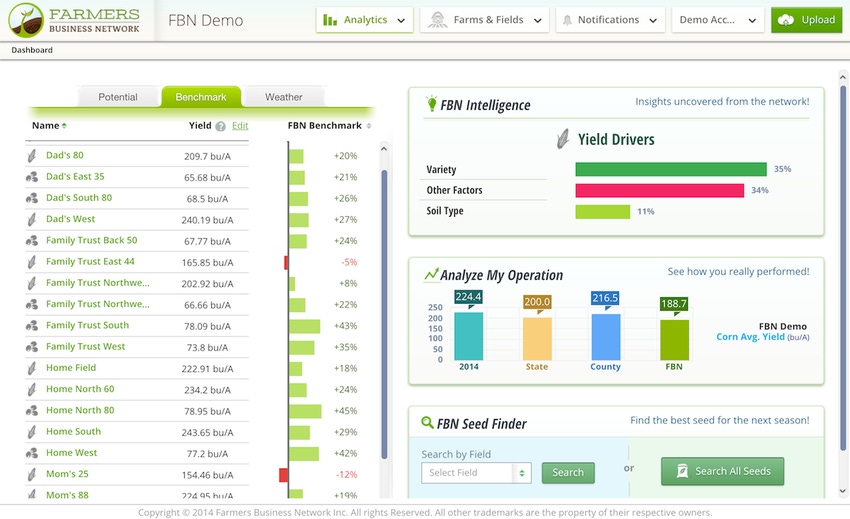
Think DifferentIllinois farmer Steve Pitstick uses aggregated crop performance data collected from other farmers like him to:Choose the best corn hybrids and soybean varietiesSelect the best planting populations for top economic performancePlace hybrids on soils where they are likely to perform best
November 6, 2015

This fall, as Steve Pitstick scans his combine’s windshield and yield monitor assessing performance of his Illinois farm, he also keeps an eye on his tablet computer as it displays harvest data from thousands of farms and millions of acres across the Corn Belt.
Prior to harvest, the new opportunities from the data streaming to his tablet was top of mind for Pitstick. So too was the changing information landscape that will emerge as he and other farmers participate in the first-ever widespread collection and dissemination of real-time on-farm harvest data.
“One of the things I think is really cool is that as yield data streams wirelessly from farmers’ yield monitors, I can start looking at trends about 20 percent into the harvest and start making hybrid decisions for 2016,” says Pitstick, who farms near Maple Park, just east of Dekalb. “Every decision we make now is based on someone else’s data. Crowd-sourcing data from large numbers of farms will be huge. This will level the playing field when it comes to information on crop performance.”
Data-sharing revolution
Pitstick is one of more than 1,200 farmers who had enrolled in Farmers Business Network (FBN) as of September. New to the market for 2015, FBN collects and analyzes full-field crop performance data from farmers, then distributes aggregate data back to them through its website.
The company charges a flat annual fee of $500 no matter how large or small the operation. The fee includes unlimited uploading, clean-up, storage, and mapping of yield and other precision data such as variable-rate planting, chemical, fertilizer application and soil sampling, says Charles Baron, a former Google program manager and one of FBN’s founders.
“The idea for this came from farmers we knew in Illinois,” says Baron. “They wondered if there was some way they could share precision data to learn from each other while keeping the individual data private.”
After beta testing in 2014, FBN unveiled its service in January 2015. Participating farmers, who collectively operate about 5 million acres, had uploaded 18 million acres of crop performance data from previous growing seasons as of September. The rapid growth has been made possible in part by back-shop efforts that allow data to be uploaded from all current and past yield monitors, as well as all current and past precision monitors and cloud-based data transfer services like those from John Deere and Precision Planting, says Baron.
Besides the seed performance feature (called FBN Seed Finder), FBN also offers participants a field-by-field analysis of how various practices perform, yield benchmarking, field mapping and whole-farm analysis of factors that affected yield. Although corn, soybeans and wheat dominate the FBN data, it had collected data on 18 crops grown by farmers in 23 states as of fall 2015.
Seed Finder tests
After signing up with FBN in early 2015, Pitstick uploaded precision application and yield data from the previous two years to help him finalize seed selections and field placements for the 2015 crop.
“I plant 12 different hybrids, and the FBN data showed that overall they performed well,” he says. After reevaluating his prospective hybrid lineup, he made a couple of changes, including which fields would be best suited to some of the numbers.
“On a couple of the hybrids, my thought before looking at the FBN data was to plant them in fields with certain soil types, but I saw in the FBN data that they would perform better on
other fields,” he says.
He also refined planting populations. “On one of my hybrids, the FBN data supported 33,000 seeds/acre as the most profitable seeding rate instead of 36,000 that had been recommended,” he says. That saved him $12/acre in seed costs. Over 40 acres, it was enough to roughly pay for the FBN subscription.
“I did not make whole operation changes based on the FBN data in 2015,” he says. For 2016, he will consider broader changes.
“My entire hybrid lineup will be more open than in 2015,” he says. “I think I am pretty good at choosing the best hybrids for my operation, but the FBN data will give me more confidence that I am right. The FBN data definitely will help me place them better.”
He feels the most comfortable with FBN data with lots of acres behind it, less so for data backed by fewer acres. “When I have more of my peers involved in this, then the data gets more robust and you build confidence in it,” says Pitstick.
“FBN’s analytics gets smarter and smarter as more farmers join and data sets get bigger,” adds Baron, who notes one of the top hybrids in Illinois was represented by 24,000 acres of data going into harvest.
About the Author(s)
You May Also Like





